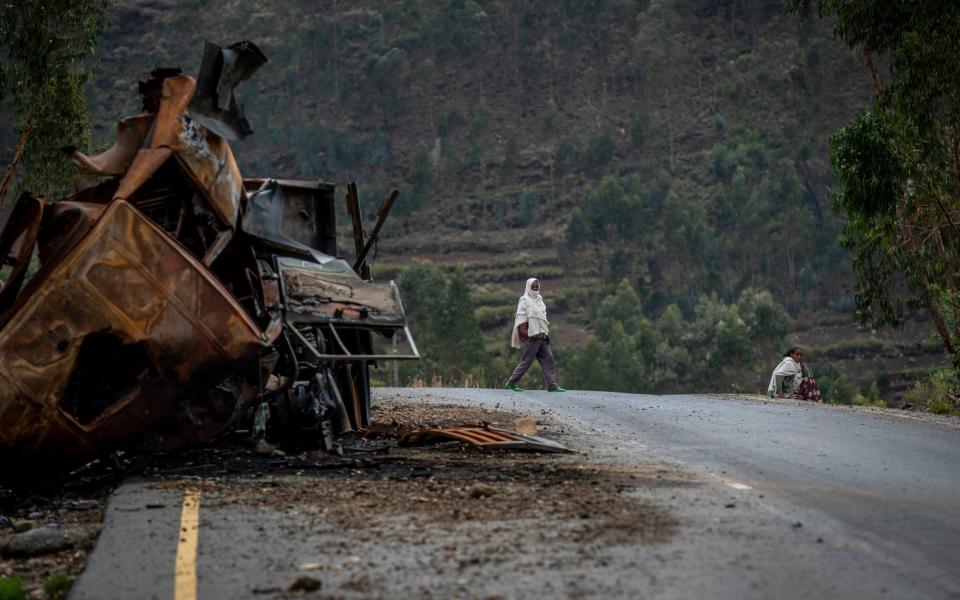How a new ‘Great War of Africa’ is raging under the cover of a media blackout

Ethiopia is becoming “Africa’s world war” with tens of thousands of deaths in the last few months potentially going unreported as Tigrayan rebels battle a coalition of armies and militias in a media blackout.
The conflict now involves hundreds of thousands of troops with both sides claiming the other is using “human wave” tactics to take positions and is likely the “deadliest war in the world”, according to analysts.
Soldiers on both sides told The Telegraph the violence was on a scale they had not seen before even after two years of fighting.
“I saw the bodies of my friends scattered. Almost everyone had died. Many wounded. I got used to hunger. I could not get rid [myself] of the scenes of dead bodies ... they wake me up at night,” said one ethnic Tigrayan fighter who recently paid £500 to a smuggler to escape the war.
Ethiopian federal forces, Eritrean soldiers and allied ethnic militias have been battling Tigrayan rebels in a desperate infantry war on four fronts across the Tigray region's mountainous terrain since a fragile ceasefire shattered in late August.

But there has been hardly any reporting on the conflict after the Ethiopia government cut phone and internet lines to the region and almost completely stopped media access to hide the extent of the fighting. Most communication with the outside world must now be done through satellite phones.
“This is the new Great War of Africa,” said Cameron Hudson, an analyst and a former head of African affairs for the US National Security Council.
“After the events of Congo 25 years ago, where as many as six African countries committed troops to a fight that ultimately killed more than five million people, Ethiopia is rapidly becoming Africa's next World War.”
‘Three hours of killing’
One Ethiopian soldier who fought there last month on the western front described it as a “blood bath”.
“We repulsed one of their attacks. It was three hours of killing. My team kept aiming at their dishka gunners,” he said, referring to a Soviet-era DShK heavy machine gun. “Later, [after an artillery strike], they were a mix of limbs and splattered brains. You don't celebrate; you just feel relieved because that could have been you. War is like that.”
The latest mass offensive is part of a horrific civil war which erupted across the northern stretch of Africa's second most populous nation in late 2020 when the Nobel Peace Prize-winning Prime Minister Abiy Ahmed attacked a dissident local government in the Tigray region.

Federal forces, ethnic militias and Eritrea soldiers joined forces to crush the well-armed Tigrayan forces in a pincer movement. Initially, it looked like the rebels had been obliterated. But in mid-2021, guerrilla fighters marched out of the mountains and retook much of the region in a stunning counter-offensive.
Eritrean forces withdrew last year and Tigrayan forces pressed toward the Ethiopian capital. For a while, it looked like Addis Ababa might fall. However, an influx of Bayraktar armed drones from Turkey and the United Arab Emirates pushed the rebels back. A months-long ceasefire offered some respite for the millions in dire straits and the conflict fell off the global agenda.
But now full-scale war is tearing the region apart again. Eritrea, a totalitarian state of about 6m, which used to be part of Ethiopia, has launched a general mobilisation calling up men in their 50s to fight.
Sources in the Tigrayan Defence Forces claim that Eritrean battalions are full of mechanised infantry brigades and are heavily equipped compared to the defenders, who often only have Ak47s.

Analysts say the sheer number of combatants from across the region and casualties are staggering.
“This has been an infantry-dominated war, particularly on the side of besieged Tigray, which over the last eighteen months or so has built a force that's said to be in the hundreds of thousands,” said William Davison, a senior Ethiopia analyst at the International Crisis Group.
“With the federal and Tigray camps claiming the other is using 'human wave' tactics, they both privately report that there have been tens of thousands of battlefield deaths just in the last month since fighting resumed.”
“Although these [casualty] numbers are probably exaggerated, given the involvement of Eritrean troops and Amhara regional forces alongside the Ethiopian federal military, it's likely that this is currently the deadliest war in the world with the largest number of combatants,” Mr Davison continued.

The allied forces seem to be trying to push towards the regional Tigrayan capital Mekelle, with wide-ranging fighting across east and in the neighbouring Amhara region to the south, where Tigrayan fighters are reportedly holed up in mountain bunkers. The worst fighting appears to be around the northwestern cities of Dedebit and Sheraro.
Experts say that the massive conflict has now sucked in many actors from across the region in an explosive situation which could send the Horn of Africa up in flames.
“You have the confirmed presence of forces who either willingly or unwillingly are fighting in this conflict from the neighbouring states: Eritrea, Somalia, and Sudan and now increasing signs that forces from as far away as Chad, Niger and Libya may also be playing a role,” said Mr Hudson.
“This comes on top of an influx of next-generation drones and battlefield munitions from Turkey, the United Arab Emirates, Russia, Iran and China, as well as previously purchased US military hardware, which has likely made this the bloodiest fight in the world today.”
Protect yourself and your family by learning more about Global Health Security

 Yahoo Movies
Yahoo Movies 